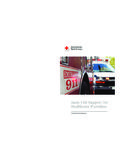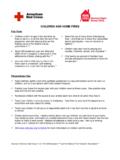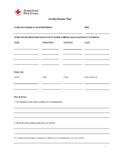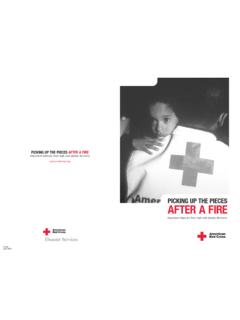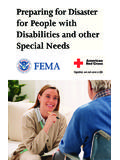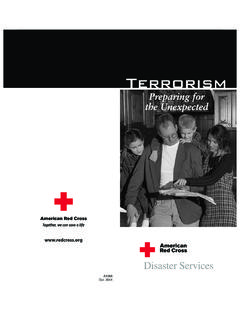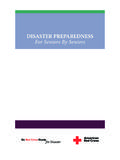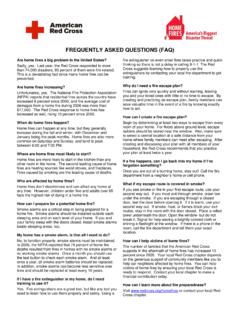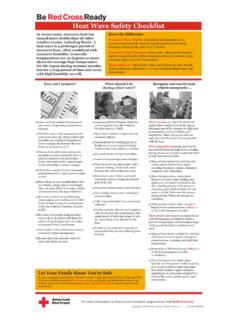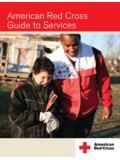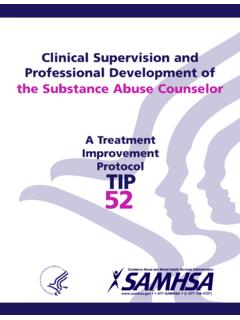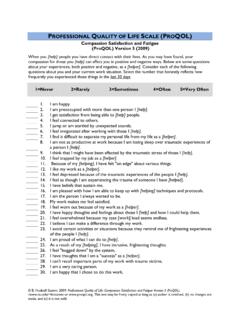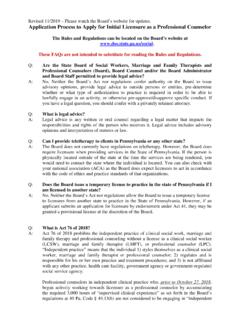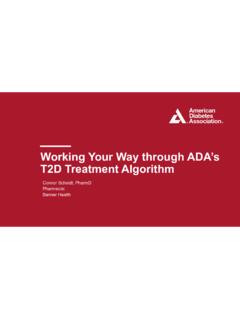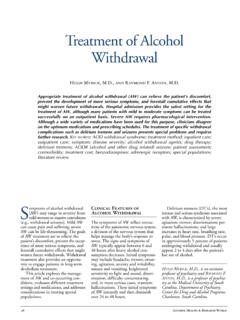Transcription of CPR/AED for Professional Rescuers and Health Care Providers
1 CPR/AED for Professional Rescuers and Health Care Providers HANDBOOKA merican Red Cross CPR/AED for Professional Rescuers and Health Care Providers HANDBOOKThis CPR/AED for Professional Rescuers and Health Care Providers Handbook is part of the American Red Cross CPR/AED for Professional Rescuers and Health Care Providers program. By itself, it does not constitute complete and comprehensive training. Visit to learn more about this emergency care procedures outlined in this book refl ect the standard of knowledge and accepted emergency practices in the United States at the time this book was published. It is the reader s responsibility to stay informed of changes in emergency care READ THE FOLLOWING TERMS AND CONDITIONS BEFORE AGREEING TO ACCESS AND DOWNLOAD THE AMERICAN RED CROSS MATERIALS.
2 BY DOWNLOADING THE MATERIALS, YOU HEREBY AGREE TO BE BOUND BY THE TERMS AND CONDITIONS. The downloadable electronic materials, including all content, graphics, images and logos, are copyrighted by and the exclusive property of The American National Red Cross ( Red Cross ). Unless otherwise indicated in writing by the Red Cross, the Red Cross grants you ( recipient ) the limited right to download, print, photocopy and use the electronic materials, subject to the following restrictions:The recipient is prohibited from selling electronic versions of the materials. The recipient is prohibited from revising, altering, adapting or modifying the recipient is prohibited from creating any derivative works incorporating, in part or in whole, the content of the recipient is prohibited from downloading the materials and putting them on their own website without Red Cross rights not expressly granted herein are reserved by the Red Cross.
3 The Red Cross does not permit its materials to be reproduced or published without advance written permission from the Red Cross. To request permission to reproduce or publish Red Cross materials, please submit your written request to The American National Red Cross. Copyright 2011 by The American National Red Cross. All rights reserved. The Red Cross emblem, American Red Cross and the American Red Cross logo are trademarks of The American National Red Cross and protected by various national by StayWell Health & Safety SolutionsISBN: 978-1-58480-494-9 ACKNOWLEDGMENTSThis handbook is dedicated to the thousands of employees and volunteers of the American Red Cross who contribute their time and talent to supporting and teaching lifesaving skills worldwide and to the thousands of course participants and other readers who have decided to be prepared to take action when an emergency strikes.
4 Many individuals shared in the development and revision process in various supportive, technical and creative ways. The American Red Cross CPR/AED for Professional Rescuers and Health Care Providers Handbook was developed through the dedication of employees and volunteers. Their commitment to excellence made this handbook care steps outlined within this product are consistent with the Guidelines 2010 for First Aid and the 2010 Consensus on Science for Cardiopulmonary Resuscitation and Emergency Cardiovascular Care. These treatment recommendations and related training guidelines have been reviewed by the American Red Cross Scientifi c Advisory Council, a panel of nationally recognized experts in fi elds that include emergency medicine, occupational Health , sports medicine, school and public Health , emergency medical services (EMS), aquatics, emergency preparedness and disaster | CPR/AED for Professional Rescuers and Health Care ProvidersTABLE OF CONTENTSSECTION 1.
5 THE Professional RESCUERThe Duty to Respond _____2 Preventing the Spread of Bloodborne Pathogens _____3 Taking Action _____5 Recovery Positions _____9 Summoning More Advanced Medical Personnel _____9 Moving a Victim _____10 Breathing Emergencies _____10 Giving Ventilations _____12 Airway Obstruction _____12 Cardiac Emergencies _____13 Cardiac Arrest _____15 CPR _____15 AEDs _____17 SECTION 2: SKILL SHEETSR emoving Disposable Gloves _____21 Primary Assessment Adult _____22 Primary Assessment Child and Infant _____24 Recovery Positions _____26 Giving Ventilations _____27 Giving Ventilations Using a Bag-Valve-MaskResuscitator Two Rescuers _____28 Conscious Choking Adult and Child _____30 Conscious Choking Infant _____32 Unconscious Choking _____34 CPR _____36 Two-Rescuer CPR _____38 Using an AED _____40 SECTION1 THE Professional RESCUER2 | CPR/AED for Professional Rescuers and Health Care ProvidersTHE DUTY TO RESPONDIn many professions, there is a job-related duty to act in an emergency and provide care.
6 Your actions are often critical and may determine whether a seriously injured or ill victim survives. Legal ConsiderationsLaws vary from state to state so you should inquire about your state s specifi c laws for the following legal considerations: Duty to act: The duty to respond to an emergency and provide care. Failure to fulfi ll these duties could result in legal action. Scope of practice: The range of duties and skills you have acquired in training that you are authorized by your certifi cation to of care: The public s expectation that personnel summoned to an emergency will provide care with a certain level of knowledge and skill. Negligence: Failure to follow a reasonable standard of care, thereby causing or contributing to injury or damage.
7 Consent: A victim s indication that a rescuer may provide care. Consent must fi rst be obtained, either verbally or through a gesture, before providing care to an injured or ill victim. To obtain consent: Identify yourself to the victim. cState your level of training. cAsk the victim whether you may help. cExplain what you observe. cExplain what you plan to do. cWhen an adult is unable to give consent, such as if he or she is unconscious, confused, mentally impaired, seriously injured or seriously ill, consent is implied. This means the law assumes the victim would give consent if able. For a minor, you must obtain consent from a parent or guardian. If the condition is life threatening and a parent or guardian is not present, consent is of care: A victim s indication that a rescuer may not provide care.
8 Refusal of care must be honored, even if the victim is seriously injured or ill or desperately needs assistance. A victim can refuse some or all care. If a witness is available, have the witness listen to, and document in writing, any refusal of directives: Written instructions that describe a person s wishes regarding medical treatment or Health care decisions. Guidance for advance directives, including any required identifi cation and verifi cation process, is documented in state, regional or local SECTION 1 - The Professional Rescuer | 3 laws, statutes and/or protocols and must be followed. Advance directives include:Do Not Resuscitate (DNR) orders (also called Do Not Attempt cResuscitation [DNAR] orders).Living wills. cDurable powers of attorney.
9 CBattery: The unlawful, harmful or offensive touching of a person without the person s consent. Abandonment: Discontinuing care once it has begun. You must continue care until someone with equal or more advanced training takes over. Confi dentiality: The principle that information learned while providing care to a victim is private and should not be shared with anyone except emergency medical services (EMS) personnel directly associated with the victim s medical care. Documentation: An established, written record of the events that took place, the care that was provided and the facts you discovered after the incident occurred. PREVENTING THE SPREAD OF BLOODBORNE PATHOGENSB loodborne pathogens, such as bacteria and viruses, are present in blood and body fl uids and can cause disease (Table 1).
10 Table 1: Bloodborne Pathogens of Primary ConcernNameDescriptionVaccineHepatitis BLiver infection caused by the hepatitis B virusHepatitis B vaccination series (must be made available within 10 working days of initial assignment, after appropriate training has been completed, to all employees who have occupational exposure)Hepatitis CLiver disease caused by the hepatitis C virusNoneHIVV irus that causes AIDS; attacks white blood cells and destroys the body s ability to fi ght infectionNone4 | CPR/AED for Professional Rescuers and Health Care ProvidersOSHA RegulationsOccupational Safety and Health Administration (OSHA) regulations and guidelines:Apply to employees who may come into contact with blood or other body fl uids that could cause infection.
